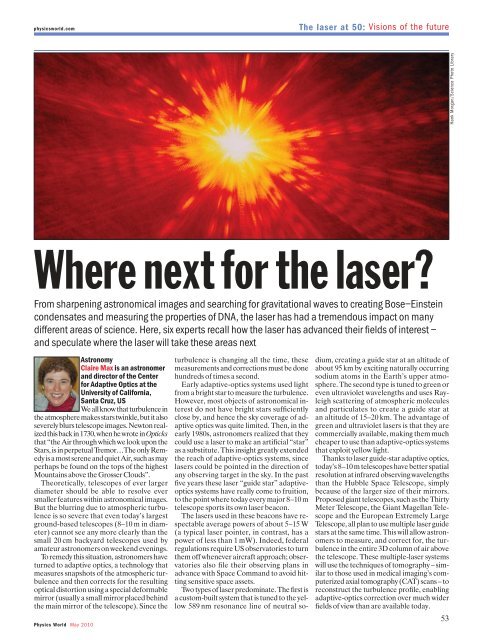special issue
special issue
special issue
Create successful ePaper yourself
Turn your PDF publications into a flip-book with our unique Google optimized e-Paper software.
physicsworld.comThe laser at 50: Visions of the futureHank Morgan/Science Photo LibraryWhere next for the laser?From sharpening astronomical images and searching for gravitational waves to creating Bose–Einsteincondensates and measuring the properties of DNA, the laser has had a tremendous impact on manydifferent areas of science. Here, six experts recall how the laser has advanced their fields of interest –and speculate where the laser will take these areas nextAstronomyClaire Max is an astronomerand director of the Centerfor Adaptive Optics at theUniversity of California,Santa Cruz, USWe all know that turbulence inthe atmo sphere makes stars twinkle, but it alsoseverely blurs telescope images. Newton realizedthis back in 1730, when he wrote in Opticksthat “the Air through which we look upon theStars, is in perpetual Tremor… The only Rem -edy is a most serene and quiet Air, such as mayperhaps be found on the tops of the highestMoun tains above the Grosser Clouds”.Theoretically, telescopes of ever largerdiameter should be able to resolve eversmaller features within astronomical images.But the blurring due to atmospheric turbulenceis so severe that even today’s largestground-based telescopes (8–10 m in diameter)cannot see any more clearly than thesmall 20 cm backyard telescopes used byamateur astronomers on weekend evenings.To remedy this situation, astronomers haveturned to adaptive optics, a technology thatmeasures snapshots of the atmospheric turbulenceand then corrects for the resultingoptical distortion using a <strong>special</strong> deformablemirror (usually a small mirror placed behindthe main mirror of the telescope). Since thePhysics World May 2010turbulence is changing all the time, thesemeasurements and corrections must be donehundreds of times a second.Early adaptive-optics systems used lightfrom a bright star to measure the turbulence.However, most objects of astronomical in -terest do not have bright stars sufficientlyclose by, and hence the sky coverage of ad -aptive optics was quite limited. Then, in theearly 1980s, astronomers realized that theycould use a laser to make an artificial “star”as a substitute. This insight greatly extendedthe reach of adaptive-optics systems, sincelasers could be pointed in the direction ofany observing target in the sky. In the pastfive years these laser “guide star” adaptiveopticssystems have really come to fruition,to the point where today every major 8–10 mtelescope sports its own laser beacon.The lasers used in these beacons have re -spectable average powers of about 5– 15 W(a typical laser pointer, in contrast, has apower of less than 1 mW). Indeed, federalregulations require US observatories to turnthem off whenever aircraft approach; observatoriesalso file their observing plans inadvance with Space Command to avoid hittingsensitive space assets.Two types of laser predominate. The first isa custom-built system that is tuned to the yellow589 nm reson ance line of neutral so -dium, creating a guide star at an altitude ofabout 95 km by exciting naturally occurringsodium atoms in the Earth’s upper atmo -sphere. The second type is tuned to green oreven ultraviolet wavelengths and uses Ray -leigh scattering of atmospheric moleculesand particulates to create a guide star atan altitude of 15– 20 km. The advantage ofgreen and ultraviolet lasers is that they arecommercially available, making them muchcheaper to use than adaptive-optics systemsthat exploit yellow light.Thanks to laser guide-star adaptive optics,today’s 8–10 m telescopes have better spatialresolution at infrared observing wavelengthsthan the Hubble Space Telescope, simplybecause of the larger size of their mirrors.Proposed giant telescopes, such as the ThirtyMeter Telescope, the Giant Magel lan Tele -scope and the European Extremely LargeTelescope, all plan to use multiple laser guidestars at the same time. This will allow astron -omers to measure, and correct for, the turbulencein the entire 3D column of air abovethe telescope. These multiple-laser systemswill use the techniques of tomography – similarto those used in medical imaging’s computerizedaxial tomography (CAT) scans – toreconstruct the turbulence profile, enablingadaptive-optics correction over much widerfields of view than are available today.53



